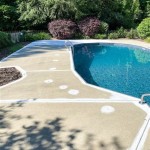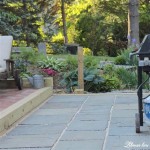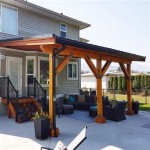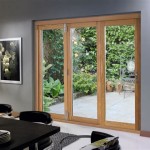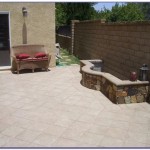Turning Your Backyard Into a Patio Paradise: A Parks and Recreation Approach
Creating an appealing and functional outdoor living space, akin to the well-maintained parks and recreation facilities often seen within communities, can significantly enhance the enjoyment and value of a home. A well-designed patio serves as an extension of the indoor living area, offering a space for relaxation, entertainment, and connection with nature. This article will explore key considerations in transforming a backyard into a patio paradise, drawing inspiration from the principles of thoughtful planning and resource management prevalent in parks and recreation projects.
Planning and Design: Establishing a Foundation for Success
The initial stage of patio development requires careful planning and design. This phase should encompass a thorough assessment of the existing backyard landscape, considering factors such as size, topography, sun exposure, drainage, and existing vegetation. From a Parks and Recreation perspective, this is akin to conducting a site analysis before developing a new park or recreational area.
A crucial element of the design process involves defining the intended use of the patio. Will it primarily serve as a dining area, a lounge space, a cooking area, or a combination of these? Understanding the primary function will guide decisions regarding size, layout, and the selection of appropriate materials and furnishings. For instance, a patio designed for outdoor dining will require ample space for a table and chairs, while a lounge area may prioritize comfortable seating arrangements and shaded areas.
Consideration should also be given to the overall aesthetic. The patio design should complement the architectural style of the house and blend seamlessly with the surrounding landscape. Drawing inspiration from the natural elements found in parks – such as stone, wood, and native plants – can create a cohesive and visually appealing outdoor space. The use of landscape design principles, such as balance, proportion, and rhythm, can further enhance the visual appeal of the patio.
Accessibility is another important factor to consider. Ensure that the patio is easily accessible from the house, ideally with a direct connection to the kitchen or living area. Consider the use of walkways and pathways to connect the patio to other areas of the yard, such as gardens, pools, or play areas. Universal design principles, which prioritize accessibility for people of all abilities, should be incorporated into the design whenever possible. This mirrors the Parks and Recreation ethos of creating inclusive spaces for all members of the community.
Finally, the planning and design phase should include a detailed budget. This will help to prioritize expenses and ensure that the project stays within financial constraints. Research the cost of materials, labor, and any necessary permits. Consider phasing the project if necessary, starting with the essential elements and adding additional features over time.
Material Selection: Prioritizing Durability, Aesthetics, and Sustainability
The choice of materials plays a significant role in the durability, aesthetics, and overall cost of the patio. A wide range of materials are available, each with its own advantages and disadvantages. Common patio materials include concrete pavers, natural stone, brick, wood, and composite decking. Selecting the right material depends on factors such as budget, style preferences, and the desired level of maintenance.
Concrete pavers are a popular choice due to their affordability, versatility, and durability. They are available in a variety of shapes, sizes, colors, and textures, allowing for a wide range of design possibilities. Concrete pavers are also relatively easy to install and maintain. They are a great analogy to the concrete pathways found in many community parks due to their durability.
Natural stone, such as flagstone, slate, and limestone, offers a more natural and upscale look. Natural stone is highly durable and can withstand harsh weather conditions. However, it is generally more expensive than concrete pavers and may require more specialized installation. The use of locally sourced natural stone can also contribute to the sustainability of the project, reducing transportation costs and supporting local businesses.
Brick is a classic patio material that offers a timeless and elegant look. Brick is durable, low-maintenance, and relatively easy to install. It is also available in a variety of colors and textures. However, brick can be susceptible to cracking in colder climates. Brick brings to mind the brick pathways often found in historical parks.
Wood decking provides a warm and inviting surface for a patio. Wood is a natural and renewable resource, making it a sustainable choice. However, wood requires regular maintenance, such as staining or sealing, to protect it from the elements. Composite decking is a low-maintenance alternative to wood that offers similar aesthetic qualities. Composite decking is made from recycled materials and is resistant to rot, insects, and fading. Composite decking is similar in theory to the playground equipment that many Parks and Recreation professionals use to update and rejuvenate older parks.
Sustainability should be a key consideration in material selection. Choose materials that are durable, long-lasting, and require minimal maintenance. Consider using recycled or reclaimed materials whenever possible. Select materials that are locally sourced to reduce transportation costs and support local businesses. This aligns with the Parks and Recreation commitment to environmental stewardship and responsible resource management.
Elements of a Patio Paradise: Integrating Features for Enhanced Enjoyment
Beyond the basic structure of the patio, various features can be added to enhance its functionality and aesthetic appeal. These features can transform a simple patio into a true outdoor paradise. Considerations for these elements can replicate the thoughtful addition of features into Parks and Recreation projects such as shelters, gathering areas, and playground equipment.
Outdoor lighting is essential for creating a welcoming and functional patio space, especially during evenings and nighttime. Lighting can be used to highlight architectural features, create ambiance, and provide safety and security. Consider using a combination of ambient lighting, task lighting, and accent lighting to create a well-lit and inviting outdoor space. Solar-powered lighting is a sustainable option that eliminates the need for electrical wiring.
Comfortable seating is crucial for creating a relaxing and enjoyable patio experience. Choose seating that is both comfortable and durable, and that complements the overall style of the patio. Consider using a variety of seating options, such as lounge chairs, sofas, and dining chairs, to accommodate different activities and preferences. Throw pillows and cushions can add color, texture, and extra comfort.
Shade structures are essential for protecting the patio from the sun's harsh rays. Shade can be provided by trees, umbrellas, pergolas, or awnings. Trees are a natural and sustainable option that can also provide privacy and attract wildlife. Umbrellas are a portable and affordable option that can be easily moved as needed. Pergolas are a more permanent structure that can provide partial shade and support climbing plants. Awnings are a retractable option that can be adjusted to provide the desired amount of shade.
An outdoor kitchen or grilling area can transform a patio into a culinary center. Consider incorporating a built-in grill, a countertop for food preparation, and storage for cooking utensils. An outdoor sink can also be a useful addition. Ensure that the grilling area is properly ventilated to prevent smoke from entering the house. Adding an outdoor kitchen to a backyard patio transformation reflects the type of capital improvements that can reinvigorate a city park.
Water features, such as fountains, ponds, or waterfalls, can add a sense of tranquility and relaxation to a patio. The sound of water can be soothing and can help to mask unwanted noise. Water features can also attract birds and other wildlife. Ensure that the water feature is properly maintained to prevent algae growth and mosquito breeding. These features are often present in thoughtfully designed parks.
Plants and landscaping can add beauty, color, and texture to a patio. Consider using a variety of plants, including flowers, shrubs, and trees, to create a visually appealing and inviting space. Potted plants are a versatile option that can be easily moved as needed. Consider using drought-tolerant plants to conserve water. Incorporate elements of edible landscaping, such as herbs and vegetables, to add functionality to the patio. This imitates the thoughtful landscape design implemented in Parks and Recreation projects.
Outdoor entertainment systems, such as televisions and sound systems, can enhance the enjoyment of the patio. Consider installing a weatherproof television to watch movies or sports events outdoors. A sound system can provide background music or be used for parties and gatherings. Ensure that the entertainment system is properly wired and protected from the elements. The addition of such amenities to a patio can mimic Parks and Recreation improvements made during a renovation project.
By carefully planning and incorporating these elements, a backyard can be transformed into a patio paradise that offers a relaxing, functional, and visually appealing outdoor living space. The principles of thoughtful planning, resource management, and sustainability, as exemplified by Parks and Recreation projects, can guide the development of a patio that enhances the enjoyment and value of the home.

Spring Staycation 40 Ideas To Upgrade Your Backyard

Transform Your Backyard With Pavers Design Ideas

Top 10 Backyard Paver Ideas Yardzen

Outdoor Room Design 10 Ways To Create Backyard Paradise Bob Vila

Make A Backyard Paradise For Kids The Dedicated House

House Home 13 Ways To Make Your Backyard Feel Like A Resort

Create A Backyard Paradise With These 32 Ideas Extra Space Storage

Tips For Turning Your Backyard Into A Relaxing Outdoor Haven Kevin Szabo Jr Plumbing Services Local Plumber Tinley Park Il

How To Turn Your Backyard Into The Ultimate Outdoor Entertaining Space Garden Great Home Ideas

Outdoor Room Design 10 Ways To Create Backyard Paradise Bob Vila
Related Posts


